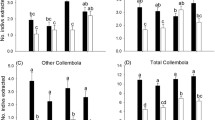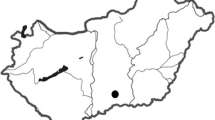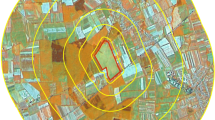Summary
Spider communities were sampled over an artificial gradient of litter depth (created by raking) and compared to those of two other forests exhibiting natural variation in litter depth. More species of spiders were present in areas of greater depth and/or complexity in all sites. Relative abundance of Lycosidae decreased, while relative abundance of Clubionidae, Thomisidae and Gnaphosidae increased over gradients of increasing depth and complexity. Similarity of species composition between areas within a forest was related to site differences in litter depth and structure.
As litter depth increased, there were significant changes in prey species richness, litter complexity, and microclimate. Partial correlation analysis of grouped data from early-, mid-, and late season suggests that influential factors change with season. In the early season, prey abundance and temperature variation account for most of the variation in spider species richness. In mid-season, litter complexity and moisture fluctuations appear to influence richness, with complexity relatively more important. In late season, complexity and temperature range were the primary factors, with temperature relatively more influential. The relative importance of these factors in influencing community structure of spiders is discussed.
Similar content being viewed by others
References
Able, L.G.: Species diversity of Decapod crustaceans in marine habitats. Ecology 55, 156–161 1974
Anderson, J.M.: Succession, diversity and trophic relationships of some soil animals in decomposing leaf litter. J. Anim. Ecol. 44, 475–495 1975
Bell, D.T., S.K. Sipp: Gradient analysis of the streamside forest in the Hart Memorial Woods, Champaign County, Illinois. III. For. Res. Rep. 74–5 1974
Bell, D.T., S.K. Sipp: The litter stratum in the streamside forest. Oikos 26, 391–397, 1975
Berry, J.W.: The distributional ecology of spiders in the old-field succession of the Piedmont region of North Carolina. Ph.D. Thesis, Duke Univ., Durham, N.C. 1967
Blalock, H.M.: Social statistics. 583 pp. New York: McGraw-Hill 1972
Breymeyer, A.: Relations between wandering spiders and other epigeic predatory Arthropoda. Ekol. Polska A 14, 18–71, 1966
Drew, L.C.: Spiders of Beaver Island. Publ. Mich. St. Mus. 3, 153–208, 1967
Duffey, E.: Spider ecology and habitat structure. Senckenbergiana Biol. 47, 45–49, 1966
Duffey, E.: The effect of human trampling on the fauna of grassland litter. Biol. Conserv. 7, 255–274, 1975
Edgar, W.D.: Prey and predators of the wolf spider, Lycosa lugubris. J. Zool. London 159, 405–411, 1969
Enders, F.: Clutch size related to hunting manner of spider species. Ann. Entomol. Soc. Amer. 69, 991–997, 1976
Ford, M.J.: Metabolic costs of the predation strategy of the spider Pardosa amentata (Clerck) (Lycosidae). Oecologia (Berl.) 28, 333–340, 1977
Gill, R.W.: Soil microarthropod abundance following oldfield litter manipulation. Ecology 50, 805–816, 1969
Hagstrum, D.W.: Ecological energetics of the spider Tarentula kochi. Ann. Entomol. Soc. Amer. 63, 1297–1304, 1970
Heatwole, H.: Analysis of the forest floor habitat with a structural classification of the litter of L layer. Ecol. Monogr. 31, 267–283, 1961
Huhta, V.: Succession in the spider communities of the forest floor after clear cutting and prescribed burning. Ann. Zool. Fenn. 8, 483–542, 1971
Janzen, D.H.: Why mountain passes are higher in the tropics. Amer. Natur. 101, 233–249, 1967
Jocque, R.: The spider fauna of adjacent woodland areas with different humus types. Biol. Jaarboek 41, 153–179, 1973
Karr, J.R.: Production, energy pathways, and community diversity in forest birds. Tropical ecological systems: Trends in terrestrial and aquatic research. In: Golley, F.B. and E. Medina (eds.), Ecological studies, Vol. II. pp. 161–176. Berlin-Heidelberg-New York: Springer Verlag 1975
Kohn, A.J.: Environmental complexity and species diversity in the gastropod genus Conus in Indo-West Pacific reef platforms. Amer. Natur. 101, 251–259, 1967
Lowrie, D.L.: The ecological succession of spiders in the Chicago area dunes. Ecology 29, 334–351, 1948
Luczak, J.D.: Differences in the structure of communities of web building spiders in one type of environment (young pine forest). Ekol. Pol. A 11, 159–221, 1963
MacArthur, R.H.: Patterns of species doversity. Biol. Rev. 40, 510–533, 1965
MacArthur, R.H., J.W. MacArthur: On bird species diversity. Ecology 42, 594–598, 1961
Moulder, B.C., D.E. Reichle: Significance of spider predation in the energy dynamics of forest floor arthropod communities. Ecol. Monogr. 42, 473–498, 1972
Murdoch, W.W., F.C. Evans, C.H. Peterson: Diversity and pattern in plants and insects. Ecology 53, 819–829, 1972
Pianka, E.R.: Latitudinal gradients in species diversity: A review of concepts. Amer. Natur. 100, 33–46, 1966
Pianka, E.R.: On lizard species diversity: North American flatland deserts. Ecology, 356 pp New York: Harper and Row, Publ., 1967
Poulson, T.L., D.C. Culver: Diversity in terrestrial cave communities. Ecology 50, 153–157, 1969
Riechert, S.E., C.R. Tracy: Thermal balance and prey availability: basis for a model relating web-site characteristics to spider reproductive success. Ecology 56, 265–284, 1975
Root, T.W., J.W. Geis, W.R. Boggess: Woddy vegetation of Hart Memorial Woods, Champaign County, Illinois, 1971
Root, R.B.: Organization of a plant-arthropod association in simple and diverse habitats: the fauna of collards (Brassica oleracea). Ecol. Monogr. 43, 95–124, 1973
Rosenzweig, M.L., J. Winakur: Population ecology of desert rodent communities: habitats and environmental complexity. Ecology 50, 558–572, 1966
Sanders, H.L.: Benthic marine diversity and the stability-time hypothesis. Brookhaven Symp. Biol. 22, 71–81, 1969
Siegel, S.: Nonparametric statistics for the behavioral sciences. New York: McGraw-Hill, 312 pp, 1956
Sokal, R.R., F.J. Rohlf: Biometry. San Francisco, W.H. Freeman 776 pp, 1969
Sorenson, T.: A method of establishing groups of equal amplitude in plant society based on similarity of species content. K. Danske Vidensk. Selsk. 5, 1–34, 1948
Uetz, G.W.: A method for measuring habitat space in studies of hardwood forest litter arthropods. Envir. Entomol. 3, 313–315, 1974
Uetz, G.W.: Temporal and spatial variation in species diversity of wandering spiders (Araneae) in deciduous forest litter. Environ. Entomol. 4, 719–724, 1975
Uetz, G.W.: Gradient analysis of spider communities in a streamside forest. Oecologia 22, 373–385, 1976
Uetz, G.W., J.D. Unzicker: Pitfall trapping in ecological studies of wandering spiders. J. Arachnol. 3, 101–111, 1976
Williams, G.: Seasonal and diurnal activity of harvestmen and spiders in contrasted habitats. J. Animal Ecol. 31, 21–42, 1962
Author information
Authors and Affiliations
Rights and permissions
About this article
Cite this article
Uetz, G.W. The influence of variation in litter habitats on spider communities. Oecologia 40, 29–42 (1979). https://doi.org/10.1007/BF00388808
Received:
Issue Date:
DOI: https://doi.org/10.1007/BF00388808




